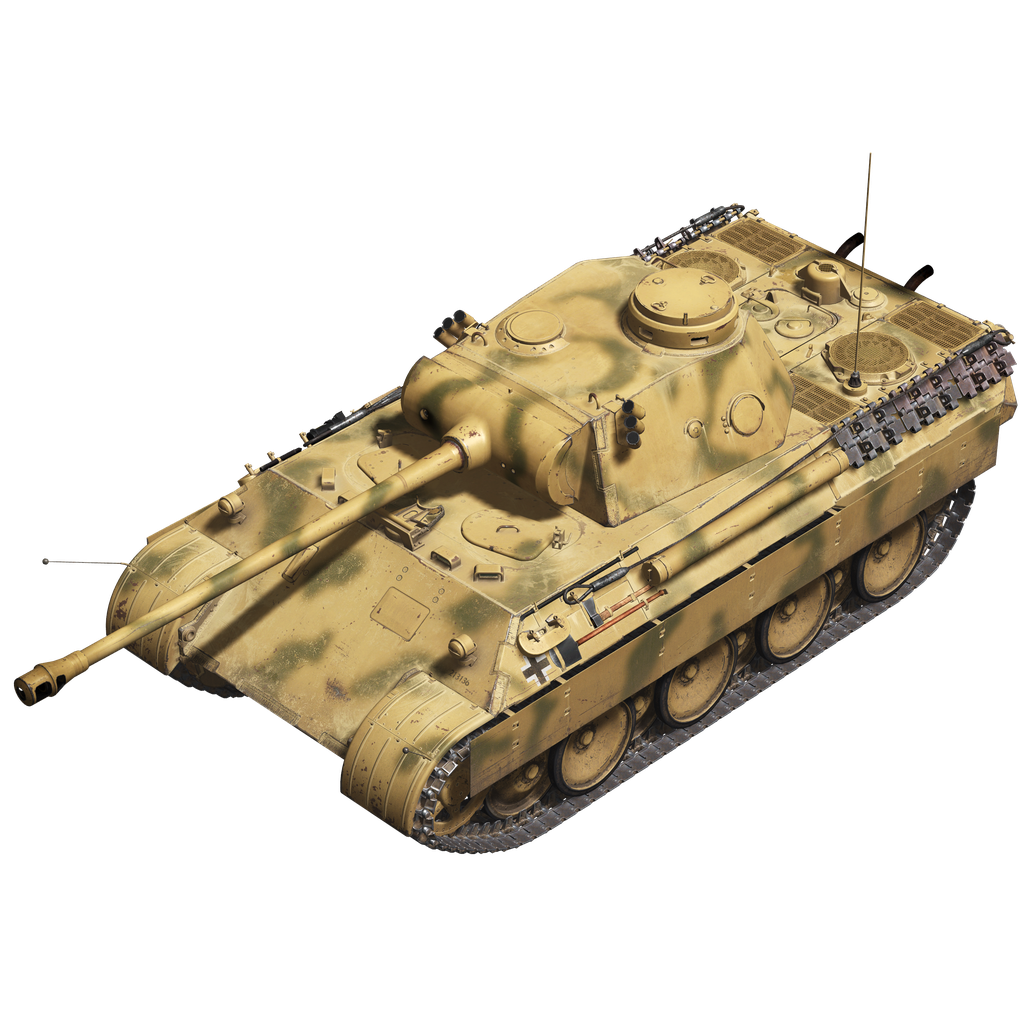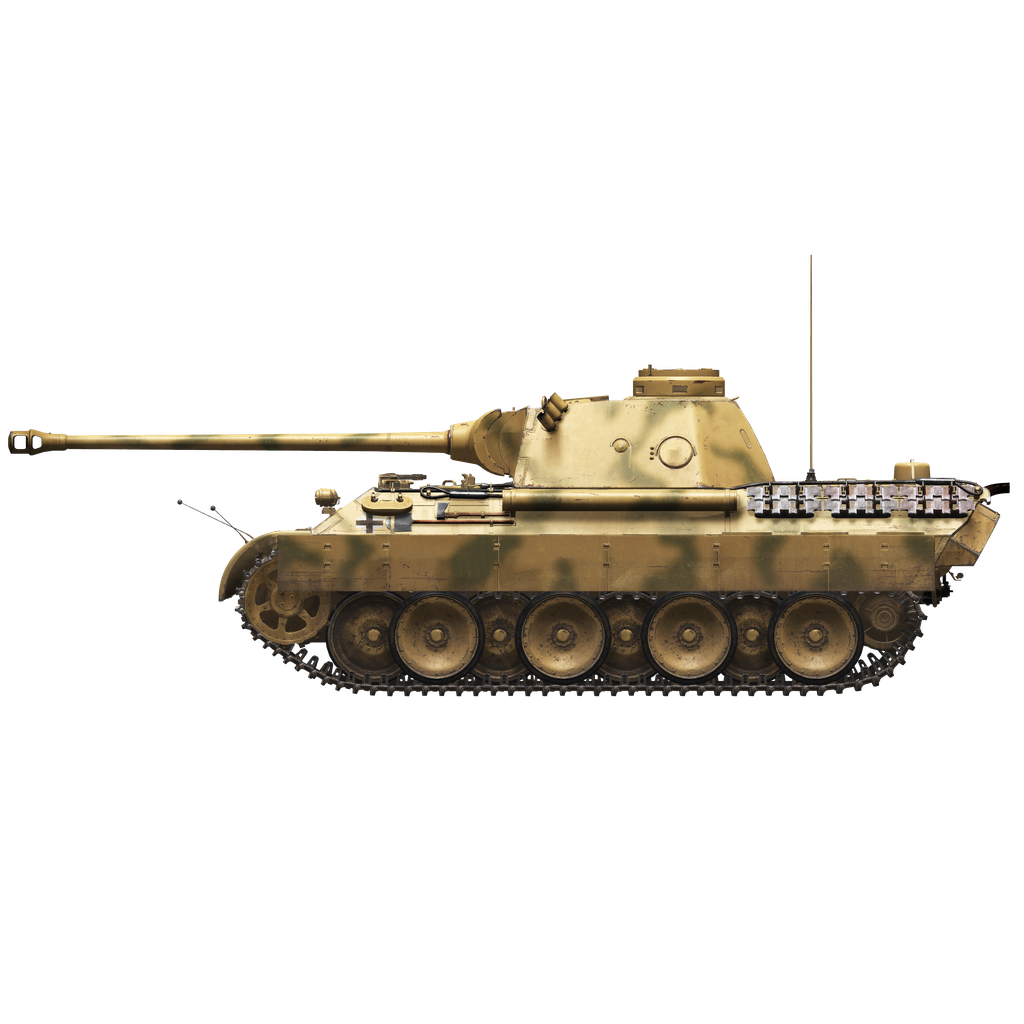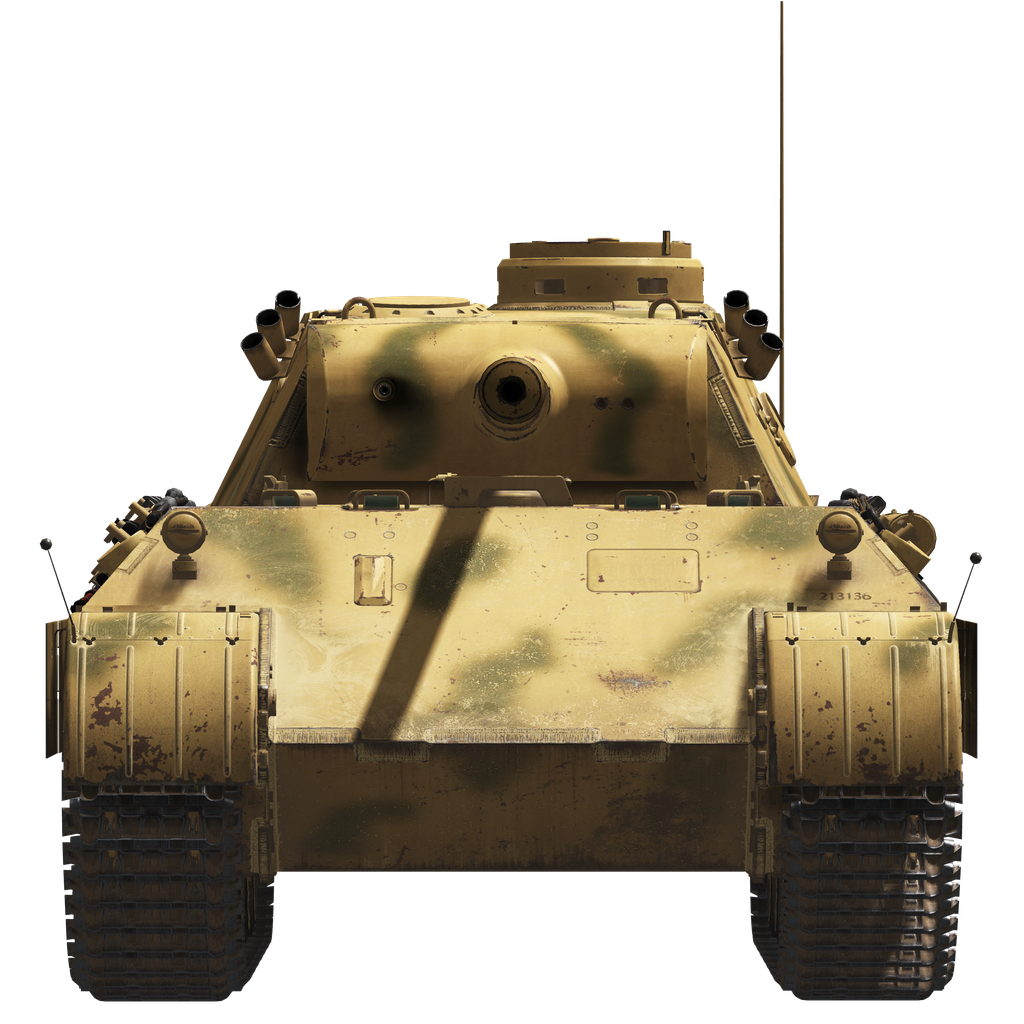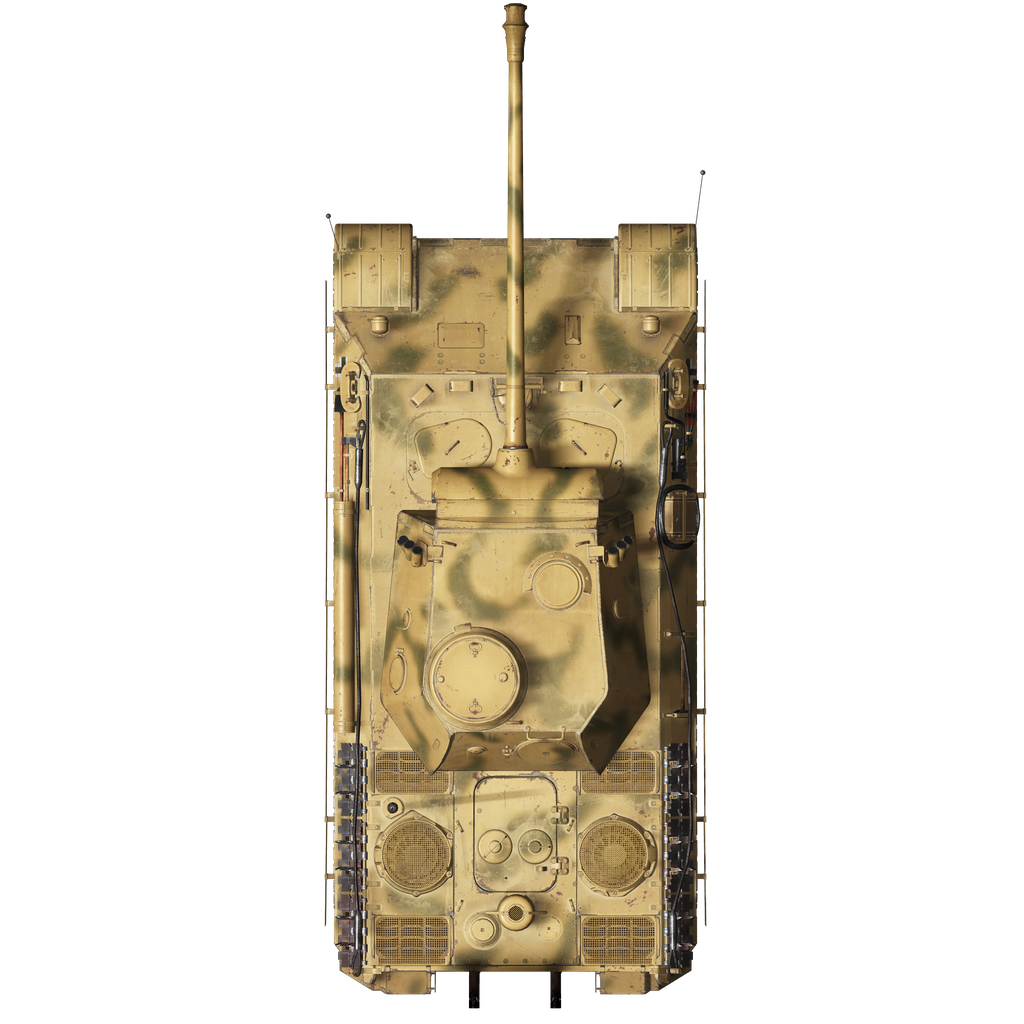Work on the design of a new medium tank to replace the Pz.IV started in Germany in 1937, but progressed slowly and only in 1941, after the battles with the T-34 tanks, did design work on the new vehicle accelerate. At first it was designed as an almost exact copy of the T-34, but eventually a MAN version was put into production, which had a traditional German layout with the transmission in the front of the tank. The vehicle received the designation Pz.Kpfw.V, and in the Wehrmacht vehicle classification system — Sd.Kfz. 171. Production of the tank began immediately after the appearance of the first prototypes, with the goal of producing the maximum possible quantity for the summer offensive planned for 1943.
According to the revised German classification of early 1943, tanks with 75 mm guns were also termed medium tanks, so the Pz.V, which had the mass of a heavy tank, was considered a medium tank in Germany. It was not until 1944 that it was given the name Panther by Hitler's personal order.
The Pz.V Ausf.D (Sd.Kfz. 171) had a classic layout with a frontal-mounted transmission. This modification differed from the prototype with a new commander's cupola, a double baffle muzzle brake, reinforced armor, and a new transmission.
The hull of the tank was welded from armor plates, joined into a tenon and welded with a double seam. The internal part of the hull was divided into three compartments: control (also known as transmission), fighting, and engine.
The control compartment was located in front of the tank. It contained seats for the driver and the radio operator-machine gunner, control levers, transmission units, control instruments, a radio station, a forward machine gun and its ammunition. The modification D had a slot in the front hull plate for a flexible machine gun, which was closed with a hinged cover.
The fighting compartment was located in the middle section; above it was a welded truncated conical turret with a cannon and a coaxial machine gun, a sight, and observation devices. There were also seats for the tank commander, gunner, and loader. Ammunition was stored in recesses in the hull and under the rotating turret floor.
The engine compartment was located in the rear and was separated from the combat compartment by an armored partition. It contained a Maybach HL 210 P30 carbureted gasoline engine.
The armament included a 75 mm KwK 42 cannon with a barrel length of 70 calibers, two rifle-caliber machine guns, and smoke grenade launchers. Types of gun shells: armor-piercing 7.5 cm Pzgr. 39/42 (6.8 kg, 925 m/s, penetrated 140 mm of armor at 500 m), sub-caliber 7.5 cm Pzgr. 40/42 (4.1 kg, 1170 m/s, penetrated 208 mm of armor at a minimum distance), high-explosive fragmentation 7.5 cm Sprgr.42 (5.74 kg, 700 m/s).
The chassis of the tank had large-diameter rollers arranged in a checkerboard pattern: a large number of these, especially since half of them were double, combined with double individual suspension provided a smooth ride and acceptable maneuverability, but such a chassis proved to be very labor-intensive to operate.
A total of 842 vehicles were built in 1943. Since the rate of production lagged behind the needs of the troops, it was decided to abandon the complete replacement of the Pz.III and Pz.IV tanks with these vehicles and to reequip only one battalion of a tank regiment in each division.
The Pz.VD saw combat for the first time during Operation Citadel at the Kursk Bulge. Its combat debut was extremely unsuccessful: 196 tanks of this type went into battle, of which 162 failed for technical reasons alone, and due to the lack of powerful recovery vehicles, 127 tanks were left on the battlefield and were captured by the Red Army.
However, rearmament with the Pz.VD continued at a rapid pace. In combat, it became clear that the Panther was a very dangerous enemy when operating from an ambush position, thanks to its long-barreled gun, which had excellent armor penetration over long combat distances. Some authors consider this vehicle to be the best German tank of WWII.
Used sources:
1. M. Baryatinsky “Heavy tank “Panther””, magazine “Armor Collection” No. 2 (11) 1997
2. A. Lobanov “Hitler’s Tank Forces” 2010
3. J. Ledwoch. "PzKpfw V Panther" 1992
Developed by MAN company in 1942, it first saw action in the Kursk battle in 1943. The tank had a powerful main gun, thick frontal armor and good mobility at the price of protection from other sides.
For the better distribution of weight and protecting the sides, its wheels were positioned in a checkerboard order, making the running gear repairs very difficult - in combat conditions its damage often led to a loss of tank. The compression stroke of the suspension was very large and it was significantly softer than on other tanks, resulting in traveling comfort. One suspension unit included two torsion bars (32 bars in total). The reliability of these machines, especially at the beginning of their production, was abysmal - only 4 of 174 were sent to the front line units by April 1943, the others were returned to the factories of origin for reworking.
The tank could be equipped with six mortars mounted on the turret and designed to shoot smoke grenades at a distance of about 80 meters.
The main gun 75 mm KwK 42 had a high muzzle velocity and could penetrate the armor of any enemy tank at significant distances.
The frontal armor protection was good, but the sides, rear and especially the bottom and roof armor of the tank was poor and provided inadequate protection from enemy tanks and guns. To improve the weak side protection, additional thin armor sheets (Schürzen) were installed.
Ausführung D modification was in production from January till September 1943 with a total of 842 units made.
Unladen weight: 45500 kg.
Length: 8.9 m.
Width: 3.4 m.
Height: 3.0 m.
Clearance: 550 mm.
Engine Maybach HL 210 P30 (petrol).
Maximum power: 650 HP at 3000 RPM.
Maximum RPM: 3000 RPM.
7 speeds gearbox.
Maximum road speed:
1-st: 4.2 kph.
2-st: 8.4 kph.
3-st: 13.2 kph.
4-st: 21.6 kph.
5-st: 30.0 kph.
6-st: 42.0 kph.
7-st: 55.2 kph.
Reverse: 4.1 kph.
Maximum offroad speed: 25 kph.
Fluids:
Internal fuel tanks capacity: 720 l.
Engine oil system capacity: 42 l.
Summer engine coolant: 120 l. of 40% glysantin
Winter engine coolant: 120 l. of 60% glysantin
Endurance range: 205 km.
Maximum oil consumption: 3.8 l/h.
Hull armour:
Upper front: 80 mm rolled armour.
Lower front: 60 mm rolled armour.
Sides: 40 mm rolled armour.
Rear: 40 mm rolled armour.
Roof: 16 mm rolled armour.
Roof grates: 20 mm cast armour.
Bottom: 16 mm rolled armour.
Bottom above tracks: 16 mm rolled armour.
Turret armour:
Front: 100 mm cast armour.
Sides: 45 mm rolled armour.
Rear: 45 mm rolled armour.
Roof: 16 mm rolled armour.
Cupola: 95 mm cast armour.
Gun mantlet: 100 mm cast armour.
Main gun: rifled, 7,5 cm KwK 42 L/70.
Barrel length: 58.1.
Elevation: +18°..-8°.
Ammo: up to 79 rounds.
Usable rate of fire: 7 rounds per minute.
Turret drive: hydraulic, 60 seconds per rotation.
Gun ammunition:
7,5 cm Pzgr. 39/42 armour piercing high explosive (APHE): 6.8 kg, 925 m/s, 140 mm at 500 m.
7,5 cm Pzgr. 40/42 armour piercing composite rigid (APCR): 4.1 kg, 1170 m/s, 208 mm point blank.
7,5 cm Sprgr.42 high explosive (HE): 5.74 kg, 700 m/s, 660 g explosives.
Machineguns: 7.92 mm Maschinengewehr MG 34.
Bullet mass: 11.5 g.
Muzzle velocity: 855 m/s.
Armour penetration at 100 m: 11 mm.
Rate of fire: 900 rounds per minute.
Coaxial: 20 belts, 150 rounds per belt (3000 rounds).
Bow: +-15°/+13°..-6°, 42 magazines, 50 rounds per magazine (2100 rounds).
Gunsights:
Tzf 12 gunner binocular scope-sight, field of view 29°.
Radio equipment:
VHF Fu 5 transceiver with additional Fu 2 receiver.
4 intercom terminals.





